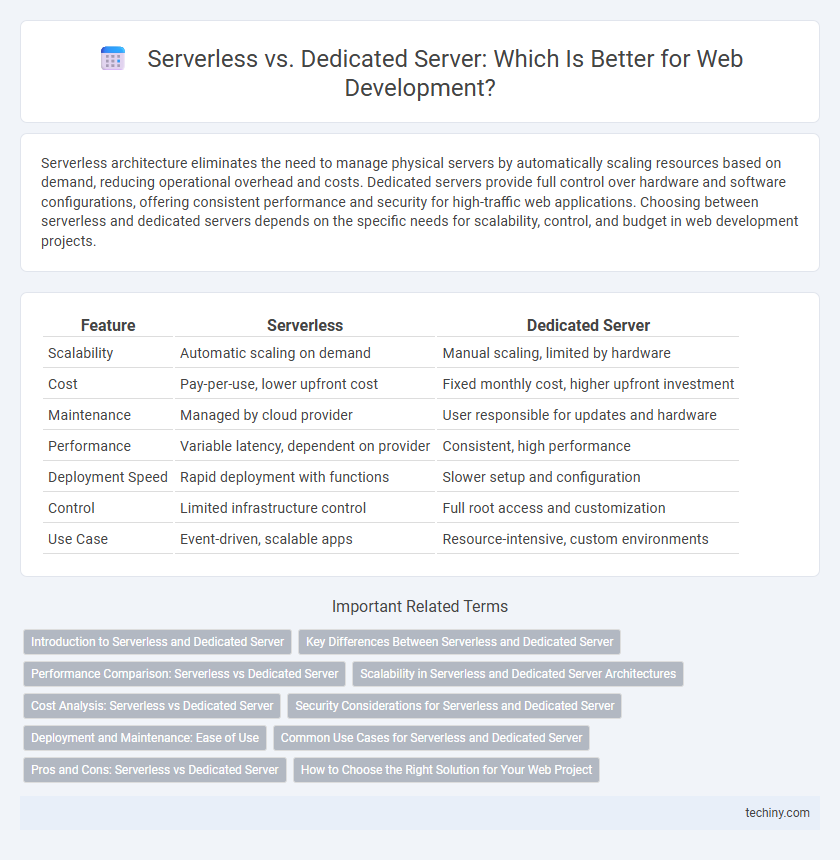Serverless architecture eliminates the need to manage physical servers by automatically scaling resources based on demand, reducing operational overhead and costs. Dedicated servers provide full control over hardware and software configurations, offering consistent performance and security for high-traffic web applications. Choosing between serverless and dedicated servers depends on the specific needs for scalability, control, and budget in web development projects.
Table of Comparison
| Feature | Serverless | Dedicated Server |
|---|---|---|
| Scalability | Automatic scaling on demand | Manual scaling, limited by hardware |
| Cost | Pay-per-use, lower upfront cost | Fixed monthly cost, higher upfront investment |
| Maintenance | Managed by cloud provider | User responsible for updates and hardware |
| Performance | Variable latency, dependent on provider | Consistent, high performance |
| Deployment Speed | Rapid deployment with functions | Slower setup and configuration |
| Control | Limited infrastructure control | Full root access and customization |
| Use Case | Event-driven, scalable apps | Resource-intensive, custom environments |
Introduction to Serverless and Dedicated Server
Serverless architecture enables developers to build and deploy applications without managing underlying infrastructure by automatically scaling resources based on demand. Dedicated servers provide exclusive hardware resources and full control over configuration, ideal for applications requiring high performance and security. Choosing between serverless and dedicated servers depends on factors like workload variability, scalability needs, and maintenance preferences.
Key Differences Between Serverless and Dedicated Server
Serverless computing eliminates the need to manage physical infrastructure by automatically scaling resources based on demand, whereas dedicated servers require manual management and fixed capacity allocation. Serverless architectures offer event-driven execution and cost efficiency through pay-as-you-go pricing, contrasting with dedicated servers that incur consistent costs regardless of usage. Performance predictability favors dedicated servers due to exclusive hardware resources, while serverless environments may experience latency fluctuations during cold starts.
Performance Comparison: Serverless vs Dedicated Server
Serverless architecture offers automatic scaling and efficient resource management, resulting in variable performance based on demand and reduced latency for event-driven applications. Dedicated servers provide consistent, high-performance computing power with full resource allocation, ideal for workloads requiring predictable response times and intensive processing. Benchmark tests show dedicated servers outperform serverless solutions in sustained heavy workloads, while serverless excels in handling sporadic traffic with cost-effective scalability.
Scalability in Serverless and Dedicated Server Architectures
Serverless architectures offer automatic scalability by dynamically allocating resources based on demand, eliminating the need for manual intervention and reducing downtime during traffic spikes. Dedicated server architectures require pre-allocated resources, which can lead to limitations in handling sudden increases in workload and often necessitate costly hardware upgrades. Cloud-based serverless platforms like AWS Lambda and Azure Functions provide seamless scaling, enhancing performance and cost-efficiency compared to fixed-capacity dedicated servers.
Cost Analysis: Serverless vs Dedicated Server
Serverless computing reduces upfront infrastructure costs by charging based on actual usage, eliminating expenses related to idle server time and hardware maintenance. Dedicated servers require a fixed monthly or annual fee regardless of workload, potentially leading to higher costs during periods of low traffic. For scalable applications with variable demand, serverless models offer significant cost efficiency compared to the predictable but often higher expense of dedicated server hosting.
Security Considerations for Serverless and Dedicated Server
Serverless architecture minimizes attack surfaces by abstracting server management and providing automatic patching, reducing vulnerabilities and the risk of server misconfigurations common in dedicated servers. Dedicated servers offer complete control over security configurations, enabling tailored firewall rules, intrusion detection systems, and encryption protocols but require continuous monitoring and updates to mitigate risks. Data privacy and compliance challenges differ between the two, with serverless environments relying on cloud provider security measures while dedicated servers allow for in-house compliance enforcement.
Deployment and Maintenance: Ease of Use
Serverless deployment minimizes maintenance by abstracting server management, allowing developers to focus on code without handling infrastructure scaling or updates. Dedicated servers require manual setup, configuration, and ongoing maintenance, increasing workload and complexity. Serverless platforms offer faster deployment cycles and seamless auto-scaling, enhancing overall ease of use in web development projects.
Common Use Cases for Serverless and Dedicated Server
Serverless architecture excels in handling event-driven applications, such as real-time data processing, API backends, and microservices, where scalability and cost efficiency are critical. Dedicated servers are preferred for resource-intensive operations like high-traffic websites, large databases, and applications requiring consistent performance with full control over server configurations. Enterprises often choose dedicated servers for legacy systems and security-sensitive environments, while startups leverage serverless for rapid deployment and flexible scaling.
Pros and Cons: Serverless vs Dedicated Server
Serverless architecture offers automatic scaling, reduced infrastructure management, and cost efficiency by charging only for actual usage, while dedicated servers provide consistent performance, full control, and enhanced security for predictable workloads. Serverless environments may introduce latency during cold starts and limited customization, whereas dedicated servers require higher maintenance costs and upfront investments. Choosing between serverless and dedicated servers depends on factors such as traffic variability, application complexity, and resource control needs.
How to Choose the Right Solution for Your Web Project
Choosing the right solution for your web project depends on factors like scalability, cost, and control requirements. Serverless architecture offers automatic scaling and reduced maintenance, ideal for unpredictable workloads and rapid development. Dedicated servers provide enhanced performance and customization for resource-intensive applications demanding consistent traffic and maximum security.
Serverless vs Dedicated Server Infographic

 techiny.com
techiny.com